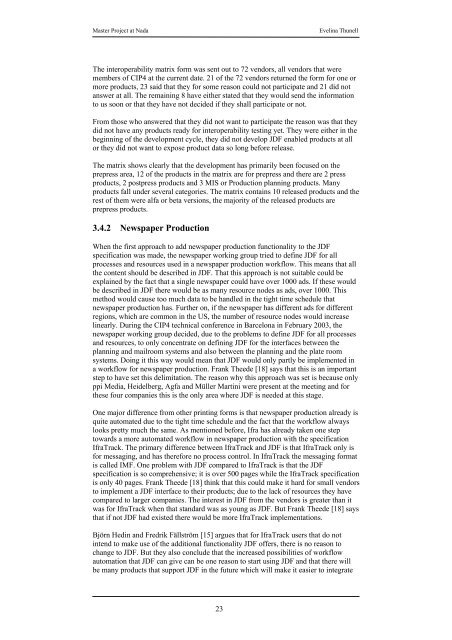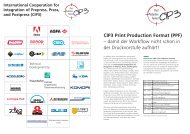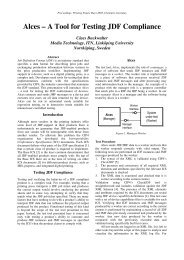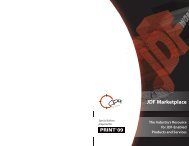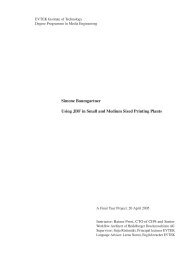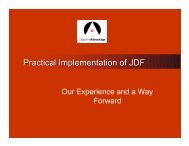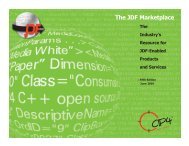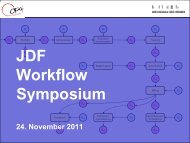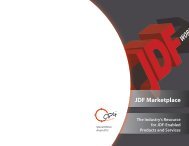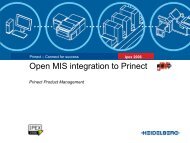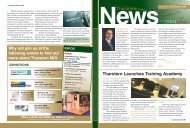You also want an ePaper? Increase the reach of your titles
YUMPU automatically turns print PDFs into web optimized ePapers that Google loves.
Master Project at Nada Evelina Thunell<br />
<strong>The</strong> interoperability matrix form was sent out to 72 vendors, all vendors that were<br />
members of <strong>CIP4</strong> at the current date. 21 of the 72 vendors returned the form for one or<br />
more products, 23 said that they for some reason could not participate and 21 did not<br />
answer at all. <strong>The</strong> remaining 8 have either stated that they would send the information<br />
to us soon or that they have not decided if they shall participate or not.<br />
From those who answered that they did not want to participate the reason was that they<br />
did not have any products ready for interoperability testing yet. <strong>The</strong>y were either in the<br />
beginning of the development cycle, they did not develop <strong>JDF</strong> enabled products at all<br />
or they did not want to expose product data so long before release.<br />
<strong>The</strong> matrix shows clearly that the development has primarily been focused on the<br />
prepress area, 12 of the products in the matrix are for prepress and there are 2 press<br />
products, 2 postpress products and 3 MIS or Production planning products. Many<br />
products fall under several categories. <strong>The</strong> matrix contains 10 released products and the<br />
rest of them were alfa or beta versions, the majority of the released products are<br />
prepress products.<br />
3.4.2 Newspaper Production<br />
When the first approach to add newspaper production functionality to the <strong>JDF</strong><br />
specification was made, the newspaper working group tried to define <strong>JDF</strong> for all<br />
processes and resources used in a newspaper production workflow. This means that all<br />
the content should be described in <strong>JDF</strong>. That this approach is not suitable could be<br />
explained by the fact that a single newspaper could have over 1000 ads. If these would<br />
be described in <strong>JDF</strong> there would be as many resource nodes as ads, over 1000. This<br />
method would cause too much data to be handled in the tight time schedule that<br />
newspaper production has. Further on, if the newspaper has different ads for different<br />
regions, which are common in the US, the number of resource nodes would increase<br />
linearly. During the <strong>CIP4</strong> technical conference in Barcelona in February 2003, the<br />
newspaper working group decided, due to the problems to define <strong>JDF</strong> for all processes<br />
and resources, to only concentrate on defining <strong>JDF</strong> for the interfaces between the<br />
planning and mailroom systems and also between the planning and the plate room<br />
systems. Doing it this way would mean that <strong>JDF</strong> would only partly be implemented in<br />
a workflow for newspaper production. Frank <strong>The</strong>ede [18] says that this is an important<br />
step to have set this delimitation. <strong>The</strong> reason why this approach was set is because only<br />
ppi Media, Heidelberg, Agfa and Müller Martini were present at the meeting and for<br />
these four companies this is the only area where <strong>JDF</strong> is needed at this stage.<br />
One major difference from other printing forms is that newspaper production already is<br />
quite automated due to the tight time schedule and the fact that the workflow always<br />
looks pretty much the same. As mentioned before, Ifra has already taken one step<br />
towards a more automated workflow in newspaper production with the specification<br />
IfraTrack. <strong>The</strong> primary difference between IfraTrack and <strong>JDF</strong> is that IfraTrack only is<br />
for messaging, and has therefore no process control. In IfraTrack the messaging format<br />
is called IMF. One problem with <strong>JDF</strong> compared to IfraTrack is that the <strong>JDF</strong><br />
specification is so comprehensive; it is over 500 pages while the IfraTrack specification<br />
is only 40 pages. Frank <strong>The</strong>ede [18] think that this could make it hard for small vendors<br />
to implement a <strong>JDF</strong> interface to their products; due to the lack of resources they have<br />
compared to larger companies. <strong>The</strong> interest in <strong>JDF</strong> from the vendors is greater than it<br />
was for IfraTrack when that standard was as young as <strong>JDF</strong>. But Frank <strong>The</strong>ede [18] says<br />
that if not <strong>JDF</strong> had existed there would be more IfraTrack implementations.<br />
Björn Hedin and Fredrik Fällström [15] argues that for IfraTrack users that do not<br />
intend to make use of the additional functionality <strong>JDF</strong> offers, there is no reason to<br />
change to <strong>JDF</strong>. But they also conclude that the increased possibilities of workflow<br />
automation that <strong>JDF</strong> can give can be one reason to start using <strong>JDF</strong> and that there will<br />
be many products that support <strong>JDF</strong> in the future which will make it easier to integrate<br />
23


